The beautiful islands of Hawaii have long been held in esteem by coffee fans who want some of the most delicious brews in the world. Of course, specialty coffees come from a huge range of countries all around the globe, but people seeking a great caffeine experience still turn to the these American classics. Hawaiian coffee is famous for its a nutty, earthy profile – often with a layer of spiciness. Its combination of earthiness- often having an almost musty quality- with snappy finish is hard to come by in other origins.
When people talk about finding the best Hawaiian coffee, they separate the different options by location where the plants are grown. This guide will help you evaluate some different Hawaiian options the next time you go shopping for a new coffee experience!
For your information, if you click on a product on Jayarrcoffee.com and decide to buy it, we may earn a small commission.
Kona
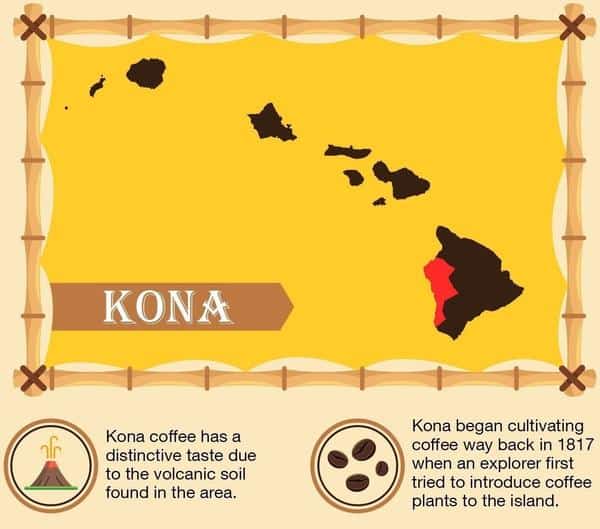
The Kona Districts of the Big Hawaii Island give the world one of the most sought after coffee varieties anywhere. It is also a variety costing more than almost every other variety. Kona coffee has a distinctive taste due to the volcanic soil found in the area; the plantations on Hawaii trail up the slopes of two massive volcanoes. This soil has a high amount of various minerals that contribute to the overall flavor.
Kona began cultivating coffee way back in 1817 when an explorer first tried to introduce coffee plants to the island. It didn’t work. It took another decade for this new crop to finally take hold and begin to flourish. The path to success and worldwide renown was not easy, however. Even after taking hold, problems with weather, workers, and pests nearly destroyed the industry completely.
Over the centuries since those early, difficult days, Kona coffee has grown to include different varieties, growing processes, and expanded set of different qualities at varying price points. Today, Kona is considered a specialty product because of the small quantities produced and the precise climate and conditions necessary to get the most sought-after taste.
The relatively high prices of Kona grown coffee, which hover around $60 per pound, come from worker wages, land use, maintenance, and materials needed to operate the plantations successfully. One of the reasons stems from the farms being on US soil, where minimum wages are much higher than in other coffee-growing parts of the world.
Koa Coffee is an excellent producer of Kona coffee. And you can save on Kona Coffee when you buy a Triple-pack!
When describing the flavor of Kona coffee, the general impression is that it is a dark roast bean with an exceptionally rich flavor, bright acidity, and often exhibiting buttery texture with spicy and winey notes.
Kauai
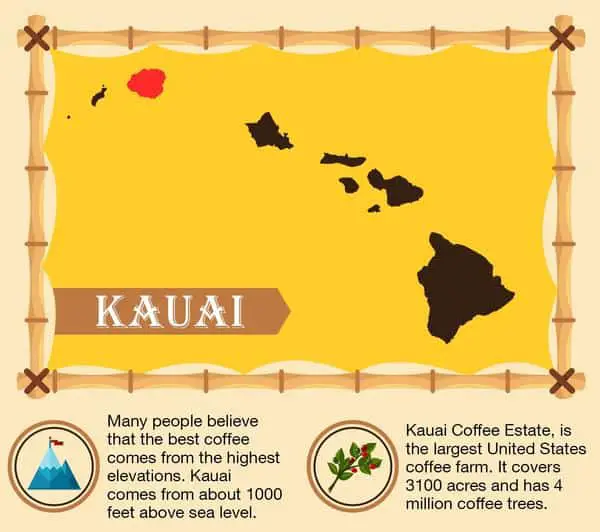
One of the most obvious differences between Kauai and Kona coffee has to do with the elevation of the fields themselves. Many people believe that the best coffee comes from the highest elevations, which would make Kona a favorite. Kauai comes from about 1000 feet above sea level instead of 4000 feet above.
The lower cultivation means less acid in the brew, softer beans overall, and a less unique taste. Many people describe it as mellow and smoother than coffee grown up higher in the mountains like you find on Kona or even Costa Rica. Besides being more generally palatable to people who enjoy a mellower taste, Kauai is also less expensive. Despite the popularity of Kona, Kauai is the more common coffee variety available on the big island.
If you are lucky enough to visit Hawaii, consider stopping by the Kauai Coffee Estate, which is the largest United States coffee farm. It covers 3100 acres and has 4 million coffee trees. You can then taste the brew for yourself and learn more about how it goes from seed to mug.
Maui
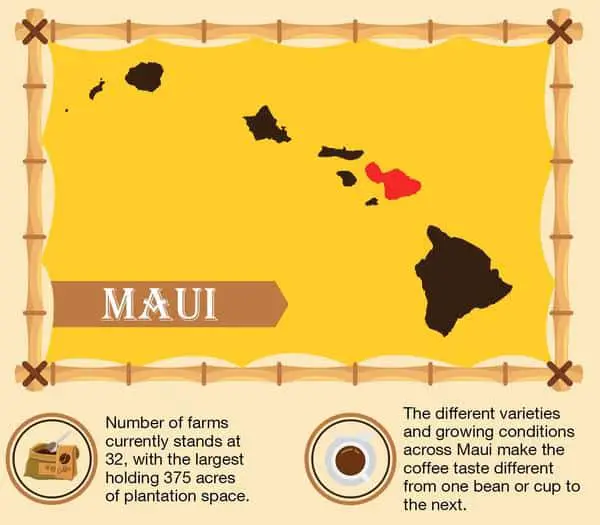
As one of the largest islands of Hawaii involved in coffee farming and production, they have a wider variety of brands using the various mountain slopes near the western side of the island. All combined, the total number of farms currently stands at 32, with the largest holding 375 acres of plantation space. Unlike some of the smaller islands that produce specialty types of coffee, the industry on Maui gets bigger all the time. Many of the old sugar plantations now focus on coffee instead.
Of course, the different varieties and growing conditions across Maui make the coffee taste different from one bean or cup to the next. One of the favorite varieties grown there is called Mokka.
Molokai
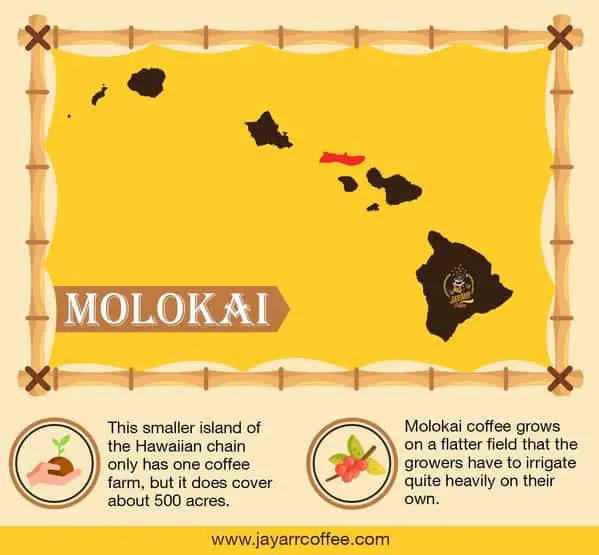
This smaller island of the Hawaiian chain only has one coffee farm, but it does cover about 500 acres and include a coffee mill for the production of roasted beans and ground product. The position of this farm makes it quite unique. Instead of up the side of a volcano, Molokai coffee grows on a flatter field that the growers have to irrigate quite heavily on their own.
A particular strain of Arabica coffee named Red Catuai grows here exclusively. It began in the 1980s and has grown since then. Although the plantation floundered some in the late 1990s, it has come back in fine fashion. Today, it offers both organic and non-organic Molokai coffee.
What is so different about this variety of coffee beans? As the Molokai plantation is at a relatively low elevation at just 850 feet above sea level, the brew created from the beans is rather mellow and smooth. Like most other locations around the islands, the ground is very rich in volcanic minerals. The two main brands that sell these beans are called Muleskinner and Estate, but they both come from the same plantation.
Muleskinner has the unique quality of being dried on the plant before harvest. The majority of other coffees are picked when fresh and then dried in a processing plant or naturally. This gives it a musty, spicy flavor that some people enjoy.
Additional Varieties
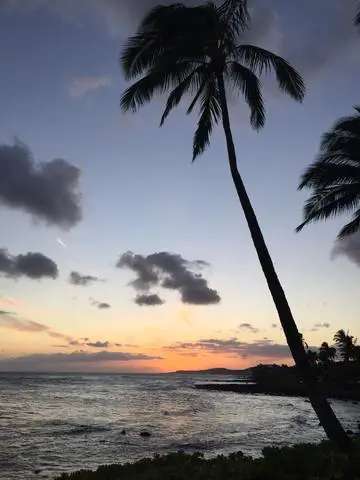
Other varieties of Hawaiian coffee exist that come from various locations and districts on the islands that make up this Pacific state. Some include Puna, Hamakua, and Ka’u. They each have their own distinct characteristics, flavors, and fanbases. If you want to explore the whole range of coffees grown in the United States, look to these and other Hawaiian specialties.
Hawaii – A Small, Varied Origin with Big Flavor
Although there are more highly prized and definitely more expensive coffees grown around the world, the different types from Hawaii have their place in the top lists. Of course, the islands here cannot compete for quantity with major coffee-producing countries like Guatamala, Brazil, and Ethiopia, but they still provide the most from the United States.
All of the plantations in this small US state total around 8200 acres. When you compare that to Brazil with approximately 6 million acres, there really is no competition. When it comes to coffee, quantity matters for many people. Most of the world enjoys this caffeinated brew every day, and most of them purchase standard Arabica grounds from the local market.
More expensive, less mass-produced, and more uniquely flavored coffees still excite fans from all around the world. Hawaii offers some of the best with Kona topping the lists with its dark and delicious taste.
